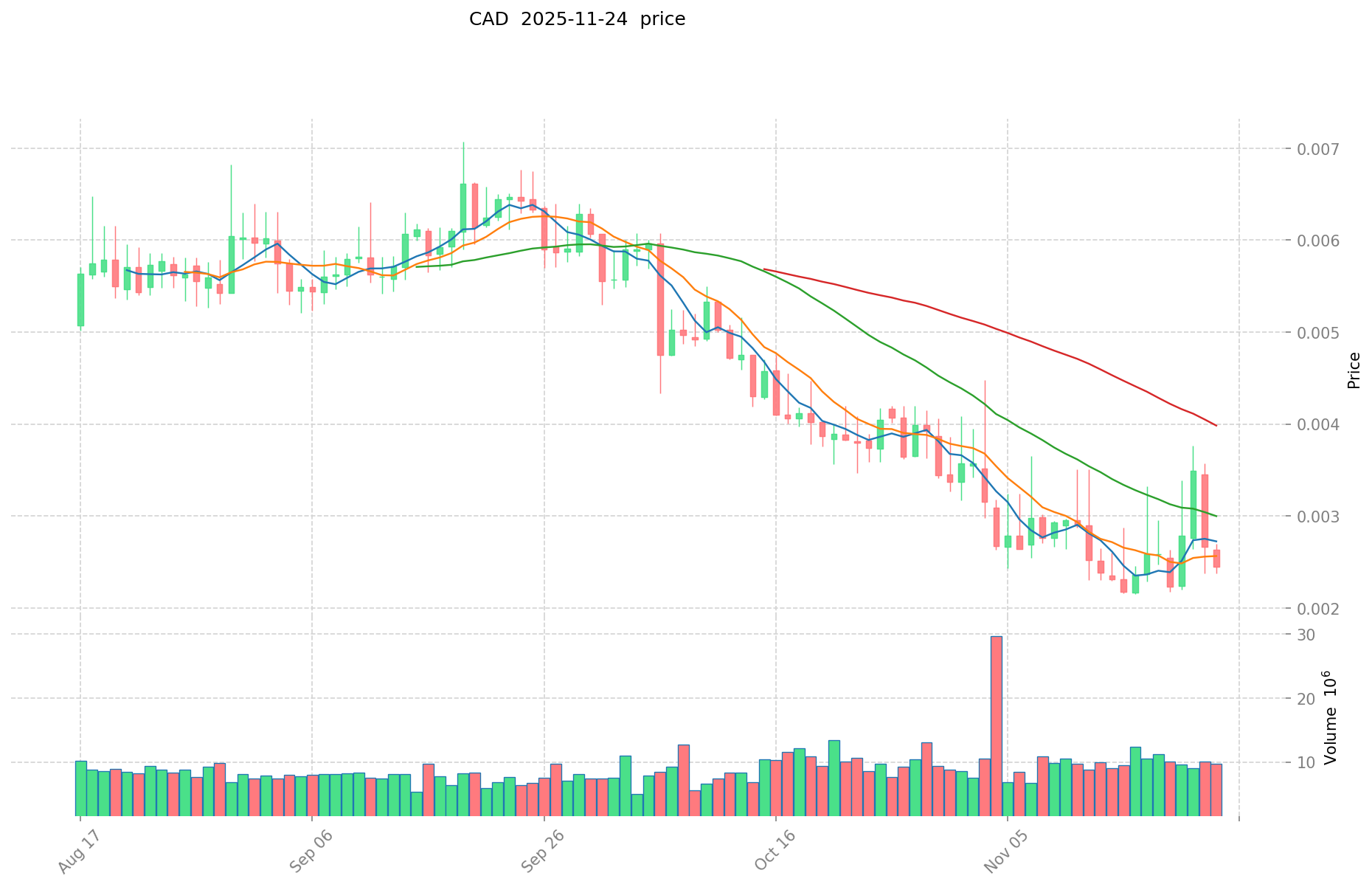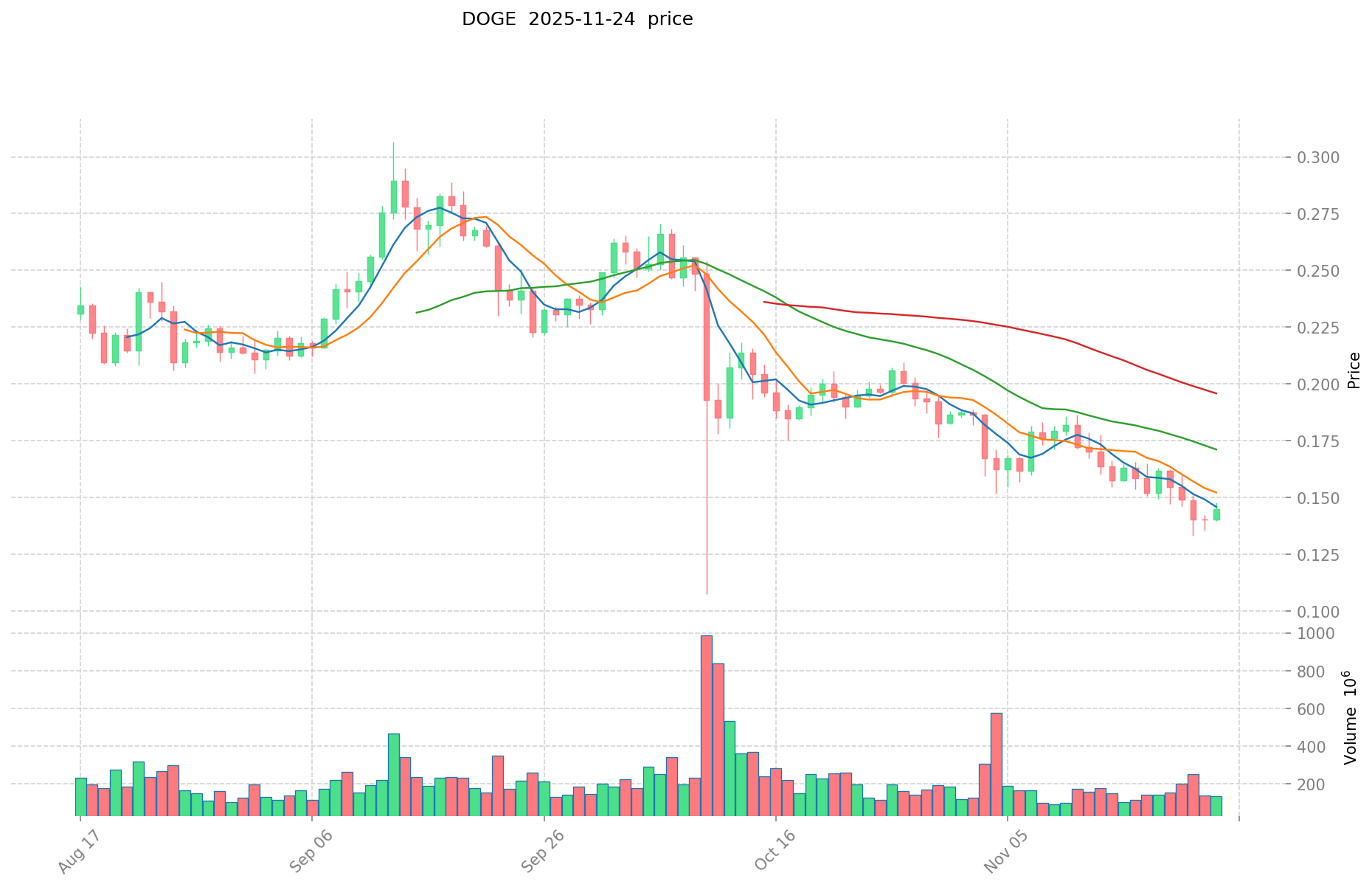CAD vs DOGE: Which Digital Currency Reigns Supreme in the Crypto Arena?
Introduction: CAD vs DOGE Investment Comparison
In the cryptocurrency market, the comparison between Caduceus Protocol (CAD) vs Dogecoin (DOGE) has always been an unavoidable topic for investors. The two not only show significant differences in market cap ranking, application scenarios, and price performance, but also represent different positioning in the crypto asset space.
Caduceus Protocol (CAD): Since its launch, it has gained market recognition for its modular infrastructure layer for Web3, AI, and Metaverse applications.
Dogecoin (DOGE): Since its inception in December 2013, it has been hailed as a "fun and light-hearted cryptocurrency," becoming one of the cryptocurrencies with the highest global trading volume and market capitalization.
This article will comprehensively analyze the investment value comparison between CAD and DOGE, focusing on historical price trends, supply mechanisms, institutional adoption, technological ecosystems, and future predictions, attempting to answer the question most concerning to investors:
"Which is the better buy right now?"
I. Price History Comparison and Current Market Status
CAD and DOGE Historical Price Trends
- 2024: CAD reached its all-time high of $0.402 on August 15, 2024.
- 2021: DOGE hit its all-time high of $0.731578 on May 8, 2021, during the cryptocurrency bull market.
- Comparative analysis: CAD has experienced a significant decline from its all-time high, dropping to a low of $0.002146 on November 16, 2025. DOGE, while also declining, has shown more resilience, currently trading at $0.14492.
Current Market Situation (2025-11-24)
- CAD current price: $0.002474
- DOGE current price: $0.14492
- 24-hour trading volume: CAD $29,199.20 vs DOGE $19,882,029.74
- Market Sentiment Index (Fear & Greed Index): 19 (Extreme Fear)
Click to view real-time prices:
- View CAD current price Market Price
- View DOGE current price Market Price


II. Core Factors Affecting Investment Value: CAD vs DOGE
Supply Mechanism Comparison (Tokenomics)
- Cardano (ADA): Fixed maximum supply of 45 billion ADA, with approximately 35.5 billion already in circulation. Uses a Proof-of-Stake consensus mechanism that rewards validators.
- Dogecoin (DOGE): Inflationary model with unlimited supply. Currently adds approximately 5 billion new DOGE annually, with over 140 billion coins already in circulation.
- 📌 Historical Pattern: Fixed-supply cryptocurrencies like ADA tend to demonstrate stronger price appreciation during bull markets compared to inflationary tokens like DOGE, though DOGE's meme status has periodically overcome this economic disadvantage during specific market cycles.
Institutional Adoption and Market Applications
- Institutional Holdings: ADA has seen more gradual institutional interest through funds like Grayscale's Digital Large Cap Fund, while DOGE gained attention through high-profile backers like Elon Musk and Mark Cuban.
- Business Adoption: ADA is positioning for enterprise blockchain solutions in developing markets, particularly in Africa, while DOGE has found use in tipping systems and is accepted by some merchants like AMC, Dallas Mavericks, and Tesla (for merchandise).
- Regulatory Stance: Both face varying regulatory scrutiny across jurisdictions, with ADA generally viewed as a technology project and DOGE often scrutinized as a speculative asset.
Technological Development and Ecosystem Building
- ADA Technical Upgrades: Cardano follows a peer-reviewed research approach with its phased roadmap (Byron, Shelley, Goguen, Basho, Voltaire). Recent implementations include Vasil hard fork for smart contract optimization and development of the Hydra scaling solution.
- DOGE Technical Development: Less active development compared to ADA, though recent efforts include reducing transaction fees and improving network performance through the Dogecoin Core upgrade.
- Ecosystem Comparison: ADA has a growing DeFi ecosystem with DEXes like SundaeSwap and MinSwap, plus NFT marketplaces. DOGE has fewer native applications but benefits from integration with payment processors and exchanges as a payment option.
Macroeconomic Factors and Market Cycles
- Inflation Performance: ADA's fixed supply potentially provides better inflation protection compared to DOGE's perpetual inflation, though neither has demonstrated consistent correlation with traditional inflation hedges.
- Monetary Policy Impact: Both cryptocurrencies show sensitivity to Federal Reserve policies and interest rate adjustments, typically declining during monetary tightening cycles.
- Geopolitical Factors: ADA may benefit from its focus on developing markets and financial inclusion, while DOGE's utility for cross-border transactions is limited by its price volatility and limited adoption for settlement purposes.
III. 2025-2030 Price Prediction: CAD vs DOGE
Short-term Prediction (2025)
- CAD: Conservative $0.00227045 - $0.002495 | Optimistic $0.002495 - $0.0033433
- DOGE: Conservative $0.1290767 - $0.14503 | Optimistic $0.14503 - $0.1537318
Mid-term Prediction (2027)
- CAD may enter a growth phase, with an estimated price range of $0.00227985615 - $0.004495491
- DOGE may enter a moderate growth phase, with an estimated price range of $0.10851028576 - $0.232279830455
- Key drivers: Institutional capital inflow, ETF, ecosystem development
Long-term Prediction (2030)
- CAD: Base scenario $0.0052493206194 - $0.00682411680522 | Optimistic scenario $0.00682411680522+
- DOGE: Base scenario $0.271399081269806 - $0.390814677028521 | Optimistic scenario $0.390814677028521+
Disclaimer: The above predictions are based on historical data and market analysis. Cryptocurrency markets are highly volatile and subject to rapid changes. These predictions should not be considered as financial advice. Always conduct your own research before making investment decisions.
CAD:
| 年份 | 预测最高价 | 预测平均价格 | 预测最低价 | 涨跌幅 |
|---|---|---|---|---|
| 2025 | 0.0033433 | 0.002495 | 0.00227045 | 8 |
| 2026 | 0.00350298 | 0.00291915 | 0.0016055325 | 27 |
| 2027 | 0.004495491 | 0.003211065 | 0.00227985615 | 40 |
| 2028 | 0.00535605642 | 0.003853278 | 0.00235049958 | 68 |
| 2029 | 0.0058939740288 | 0.00460466721 | 0.0038679204564 | 100 |
| 2030 | 0.00682411680522 | 0.0052493206194 | 0.004094470083132 | 129 |
DOGE:
| 年份 | 预测最高价 | 预测平均价格 | 预测最低价 | 涨跌幅 |
|---|---|---|---|---|
| 2025 | 0.1537318 | 0.14503 | 0.1290767 | 0 |
| 2026 | 0.189713743 | 0.1493809 | 0.113529484 | 2 |
| 2027 | 0.232279830455 | 0.1695473215 | 0.10851028576 | 16 |
| 2028 | 0.299361228206475 | 0.2009135759775 | 0.14063950318425 | 38 |
| 2029 | 0.292660760447625 | 0.250137402091987 | 0.18260030352715 | 72 |
| 2030 | 0.390814677028521 | 0.271399081269806 | 0.206263301765052 | 86 |
IV. Investment Strategy Comparison: CAD vs DOGE
Long-term vs Short-term Investment Strategies
- CAD: Suitable for investors focused on Web3, AI, and Metaverse potential
- DOGE: Suitable for investors seeking short-term trading opportunities and meme-driven momentum
Risk Management and Asset Allocation
- Conservative investors: CAD: 10% vs DOGE: 5%
- Aggressive investors: CAD: 20% vs DOGE: 15%
- Hedging tools: Stablecoin allocation, options, cross-currency portfolio
V. Potential Risk Comparison
Market Risk
- CAD: High volatility and susceptibility to market sentiment
- DOGE: Extreme price swings based on social media trends and celebrity endorsements
Technical Risk
- CAD: Scalability, network stability
- DOGE: Mining concentration, security vulnerabilities
Regulatory Risk
- Global regulatory policies may impact both differently, with DOGE potentially facing more scrutiny due to its meme status
VI. Conclusion: Which Is the Better Buy?
📌 Investment Value Summary:
- CAD advantages: Modular infrastructure for Web3, AI, and Metaverse applications
- DOGE advantages: High liquidity, strong community support, and widespread recognition
✅ Investment Advice:
- Novice investors: Consider a small allocation to DOGE for exposure to the crypto market
- Experienced investors: Research CAD's technology and potential applications before investing
- Institutional investors: Evaluate CAD's long-term potential in the Web3 ecosystem
⚠️ Risk Warning: The cryptocurrency market is highly volatile, and this article does not constitute investment advice. None
VII. FAQ
Q1: What are the main differences between CAD and DOGE? A: CAD is focused on providing a modular infrastructure layer for Web3, AI, and Metaverse applications, while DOGE started as a meme cryptocurrency and is known for its large community and high liquidity. CAD has a fixed supply, whereas DOGE has an inflationary model with unlimited supply.
Q2: Which cryptocurrency has shown better price performance recently? A: As of November 24, 2025, DOGE has shown more resilience in price performance, trading at $0.14492, while CAD has experienced a significant decline from its all-time high, currently priced at $0.002474.
Q3: How do the supply mechanisms of CAD and DOGE differ? A: CAD has a fixed maximum supply, which can potentially lead to price appreciation during bull markets. DOGE, on the other hand, has an inflationary model with unlimited supply, adding approximately 5 billion new DOGE annually.
Q4: What are the key factors affecting the investment value of CAD and DOGE? A: Key factors include supply mechanisms, institutional adoption, market applications, technological development, ecosystem building, and macroeconomic factors such as inflation and monetary policies.
Q5: Which cryptocurrency is better suited for long-term investment? A: CAD may be more suitable for long-term investors focused on Web3, AI, and Metaverse potential, while DOGE is often considered for short-term trading opportunities and meme-driven momentum.
Q6: What are the main risks associated with investing in CAD and DOGE? A: Both cryptocurrencies face market risks such as high volatility. CAD has technical risks related to scalability and network stability, while DOGE faces risks from mining concentration and potential security vulnerabilities. Both also face regulatory risks, with DOGE potentially facing more scrutiny due to its meme status.
Q7: How should investors approach allocating their portfolio between CAD and DOGE? A: Conservative investors might consider allocating 10% to CAD and 5% to DOGE, while more aggressive investors might allocate 20% to CAD and 15% to DOGE. It's important to diversify and use risk management tools such as stablecoin allocation and cross-currency portfolios.
Share
Content